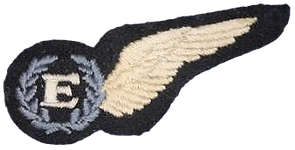
Identifying Air Force Uniforms

A photograph of your ancestor in uniform is a good starting point for identifying the military service they served in and the approximate time period of their service. Items of uniform, particularly caps and badges, can also give a good indication of your ancestor’s rank and qualification. If you are unable to identify the uniform that your ancestor is wearing in a photograph, contact Silver Wings using the Contact Form on this website. We will give you an email address to send the photo to and will provide our best interpretation of the uniform they are wearing.
Below are a few examples of the uniforms worn by Australians serving with the Australian Flying Corps or the Royal Australian Air Force. However, this is only a rough guide and not all variations of Air Force uniforms can be shown here.
World War I (1914-1918)
During World War I (1914-1918), Australian military aviation was carried out by the Australian Flying Corps (AFC) which was part of the Australian Army. These pilots, observers and mechanics wore khaki Army uniforms similar to those shown below.

AFC pilot in front of his aircraft

AFC mechanics
World War II (1939-1945)
During the 1920s, 1930s, WWII and several decades after, the Air Force winter uniform was dark blue jacket and trousers worn with a white or light blue shirt with a black tie. The summer uniform, also called ‘drabs’, was khaki long-sleeved shirt and pants with or without a khaki jacket. In tropical areas, khaki short-sleeved shirt and shorts with long socks was often worn. These uniforms, with minor changes were worn from 1921 until 1972, including through the Korean War (1950-1953) and Vietnam War (1964-1972).



Air Force winter uniform (left and centre), khaki summer uniform (right) although this jacket was normally worn with a khaki belt on the outside.


In tropical areas, khaki tropical uniform of short-sleeved shirt and shorts (left) could be worn or khaki long-sleeved shirt and pants worn with the sleeves rolled up (right)
Hats & Caps
During WWII and the years that followed, these types of headwear were commonly worn.


Service cap with airman’s badge (left) and officer’s and warrant officer’s badge (right)


Field service cap with officer’s and warrant officer’s badge (left) and a khaki fur-felt hat with airman’s badge (right). Note that unlike the Army, the Air Force fur-felt hat was never worn with the left side pinned up.
All-Seasons Uniform
In 1972, a new all-seasons uniform was introduced with the concept that it could be worn all-year-round. The colour was a lighter blue than the previous uniform and was called ‘blue/grey’. In summer, no jacket was worn and a short-sleeved shirt replaced the long-sleeved shirt and tie. There was no khaki summer uniform although the khaki tropical uniform of short sleeve shirt and shorts, continued to be worn in tropical areas.

Return to Dark Blue
In 2001, the Air Force uniform returned to the dark blue colour of the uniform it had worn for the first 50 years but still retained the ‘all-seasons’ concept. The khaki tropical uniform remained in use until 2013 when it too disappeared.



Three Air Force members are in the dark blue uniform which is both a summer and winter uniform.
A short-sleeved shirt without the tie could also be worn in hot weather.
Female Uniforms
The RAAF Nursing Service (RAAFNS) and the Women’s Australian Auxiliary Air Force (WAAAF) were formed during WWII. After the war, the RAAFNS continued but the WAAAF was disbanded. The Women’s Royal Australian Air Force (WRAAF) was formed in 1950 to complement the RAAF. In 1977, the two female services were integrated into the RAAF. Below are a few of the uniforms worn by female members.



Female Uniform in the 1940s and 1950s



On the left is the dark blue winter female uniform in the 1960s and early 1970s, in the centre is the light blue summer uniform from same time period and on the right is the all-seasons uniform from late 1970s and 1980s.
Flying Badges
Air Force flying badges are officially called ‘brevets’ (rhymes with ‘berets’) but commonly called ‘wings’. They show the aircrew specialisation of the wearer. Brevets can be embroidered in white or gold thread on a black background and are usually sewn on the left breast of the uniform jacket. Some were in the form of a silver brooch which was pinned to the left breast of the uniform shirt. As it takes a long period of hard work to qualify as aircrew and earn one these brevets, they are highly prized by Air Force personnel and are often kept as mementos of their time in the Air Force.
Pilot

Observer/Navigator
Note that from WWI until 1942, the non-pilot aircrew position was called ‘observer’ and their brevet had an ‘O’ in the centre. From 1942, the name changed to navigator and the brevet had an ‘N’ in the centre but the role of this aircrew member was unchanged.


Air Gunner
Air gunners and wireless operators/air gunners both wore the ‘AG’ brevet, however after 1944, wireless operators/air gunners replaced their AG brevets with the signaller’s brevet containing an ‘S’.

Signaller

Flight Engineer

Air Bomber

Post-1954 Brevets
From about 1954, the non-pilot brevets had a crown added to the top, as shown below.
Navigator

Flight engineer

Loadmaster

Air Electronics Officer
Later Airborne Electronics Analyst

Crewman

From about 1960, several new brevets came into use.
Flight Steward and Crew Attendant
Flight stewards were crew on RAAF passenger and VIP aircraft. The name of the mustering was changed to crew attendant about the year 2002 and the FS brevet was changed to a CA one.


After 1949, all of the above flying badges were available in the form of a silver brooch which was worn pinned to the left breast of the shirt. An example of the silver loadmaster brevet is below.

Other Brevets
Only a small selection of Air Force brevets is shown here.
More can be seen on this web page: https://militarywings.weebly.com/raaf.html